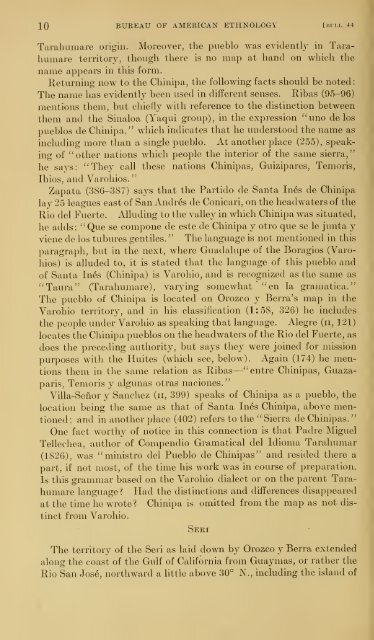Untitled - Smithsonian Institution
Untitled - Smithsonian Institution
Untitled - Smithsonian Institution
You also want an ePaper? Increase the reach of your titles
YUMPU automatically turns print PDFs into web optimized ePapers that Google loves.
"<br />
10 BUREAU OF AMERICAN ETHNOLOGY [litLi.. 44<br />
Tarahumare origin. Moreover, the pueblo was evidently in Taraliumare<br />
territory, though there is no map at hand on which the<br />
name appears in this form.<br />
Returning now to the Chinipa, the following facts should be noted<br />
The name has evidently been used in different senses. Ribas (95-96)<br />
mentions them, but chiefly with reference to the distinction between<br />
them and the Sinaloa (Yaqui group), in the expression ^'uno de los<br />
pueblos de Chinipa, " which indicates that he understood the name as<br />
including more than a single pueblo. At another place (255), speak-<br />
ing of "other nations which people the interior of the same sierra,"<br />
he says: "They call these nations Chinipas, Guizipares, Temoris,<br />
Ihios, and Varohios.<br />
Zapata (386-387) says that the Partido de Santa Ines de Chinipa<br />
lay 25 leagues east of San Andres de Conicari, on the headwaters of the<br />
Rio del Fuerte. Alluding to the valley in which Chinipa was situated,<br />
he adds: "Que se compone de este de Chinipa y otro que se le junta y<br />
viene de los tubures gentiles. " The language is not mentioned in this<br />
paragraph, but in the next, where Guadalupe of the Boragios (Varohios)<br />
is alluded to, it is stated that the language of this pueblo and<br />
of Santa Ines (Chinipa) is Varohio, and is recognized as the same as<br />
"Taura" (Tarahumare), varying somewhat "en la gramatica."<br />
The pueblo of Chinipa is located on Orozco y Berra's map in the<br />
Varohio territory, and in his classification (1:58, 326) he includes<br />
the people under Varohio as speaking that language. Alegre (ii, 121)<br />
locates the Chinipa pueblos on the headwaters of the Rio del Fuerte, as<br />
does the preceding authority, but says they were joined for mission<br />
purposes with the Huites (which see, below). Again (174) he mentions<br />
them in the same relation as Ribas— "entre Chinipas, Guaza-<br />
paris, Temoris y algunas otras naciones."<br />
Villa-Senor y Sanchez (ii, 399) speaks of Chinipa as a pueblo, the<br />
location being the same as that of Santa Ines Chinipa, above mentioned;<br />
and in another place (402) refers to the "Sierra de Chinipas."<br />
One fact worthy of notice in this connection is that Padre Miguel<br />
Tellechea, author of Compendio Gramatical del Idioma Tarahumar<br />
(1826), was "ministro del Pueblo de Chinipas" and resided there a<br />
part, if not most, of the time his work was in course of preparation.<br />
Is this grammar based on the Varohio dialect or on the parent Tarahumare<br />
language ? Had the distinctions and differences disappeared<br />
at the time he wrote? Chinipa is omitted from the map as not dis-<br />
tinct from Varohio.<br />
Seri<br />
The territory of the Seri as laid domi by Orozco y Berra extended<br />
along the coast of the Gulf of California from Guaymas, or rather the<br />
Rio San Jose, northward a little above 30° N., including the island of<br />
:

















